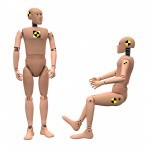Crash Test Dummies Redesigns
Crash-test dummy data has provided valuable information over  the years to help reduce fatal accidents. In the U.S., before any vehicle is sold, the vehicle manufactures must prove their safety with crash test dummies.
the years to help reduce fatal accidents. In the U.S., before any vehicle is sold, the vehicle manufactures must prove their safety with crash test dummies.
According to a report by the U.S. Department of Health and Human Services, the Centers for Disease Control and Prevention and the National Center for Health Statistics, the percentage of adults age 20 years and over who are overweight; including obesity, is 69.0% (2011-2012).
In 2010, researchers from University at Buffalo and Erie County Medical Center analyzed more than 150,000 car crashes in the United States and found that drivers considered moderately obese had a 21 percent increased risk of death. Morbidly obese drivers were 56 percent more likely to die in a crash, the study found.
ABC News reports that new studies show, “that obese drivers are 78 percent more likely to die in a car crash,” said Chris O’ Connor, CEO of Humanetics, the only U.S. producer of the dummies.
This is causing crash-test dummy makeovers to reflect American’s changing waste lines, which health organizations like the Centers for Disease Control and Prevention classify as morbidly obese. Current crash test dummies are based on a person weighing 167 pounds with a healthy body mass index. Today crash test dummies are being redesigned with measurements of 270 pounds with a body mass index of 35. They will also realistically represent the weigh distribution amongst overweight and obese individuals.
Safety organizations are learning with the help of new research that restraint systems, seatbelts, airbags and other safety features also need to do a better job protecting people of all sizes in order to save more lives and better understand the impact on injury types and severity.
The redesigned crash-test dummies will go into trial usage by the end of this year and are expected to be widely released for testing in crash simulators by the end of next year (2015). Future lines are to include elderly dummies and petite women.


